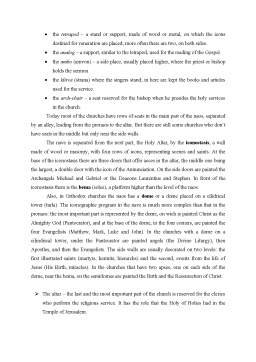Extras din referat
The term "church" has two meanings:
a) to gather believers who believe in Jesus Christ and confess His teaching unchanged and recognize Him as the Head of the Church;
b) the holy place where believers gather to pray and where the holy ministry of worship is done.
In Romanian, the term “biserică” derives from the latin word basilica: this was usually the place where the Emperor (basileios) held council, so in our times, with the same meaning, is the place where God, the Heavenly Emperor (Basileion ton Ouranon) is adored.
The church is preferably built in the middle of the parish, and if it is possible on the highest ground, to remind that Christ, as a Shepherd, is always in the midst of his flock. Christian churches are oriented to the East, from where the sun rises, and because in the Christian faith, and Christ is the Divine Light and the Unsetting Sun.
Churches are divided into three main parts, imitating the Jewish Temple in Jerusalem, each one with its own meaning:
- The pronaos or narthex - is the first part of a church, through which one enters the building. In the old times it was separated from the next part by a wall with three doors, replaced later by columns and today is unblocked. This separation existed because in here stood the people who were not yet christians and awaited baptism. In the pronaos used to be the baptismal basin, today replaced by the baptismal font or cristelniță. The artistic program present in the pronaos illustrates christian characters who fought for their salvation and serve as a model (hermits, monks like St. Anthony, Makarios or Amun, or holy wemen, like St. Mary of Egypt), and the founders of the edifice (voivodes, clerics) or those in whose area the church was built or restored; the right wall of the entrance is usually used for the dedication of the church.
- The naos or nave - is the second part, the middle one, and the most spacious, because in here stand faithful to prayer. Among the objects that usually stand in the nave, we enumerate:
- the tetrapod - a stand or support, made of wood or metal, on which the icons destined for veneration are placed; more often there are two, on both sides.
- the analog - a support, similar to the tetrapod, used for the reading of the Gospel.
- the ambo (amvon) - a side place, usually placed higher, where the priest or bishop holds the sermon
- the kliros (strana) where the singers stand; in here are kept the books and articles used for the service.
- the arch-chair - a seat reserved for the bishop when he presides the holy services in the church.
Preview document
Conținut arhivă zip
- Biserica - locas de inchinare.docx











